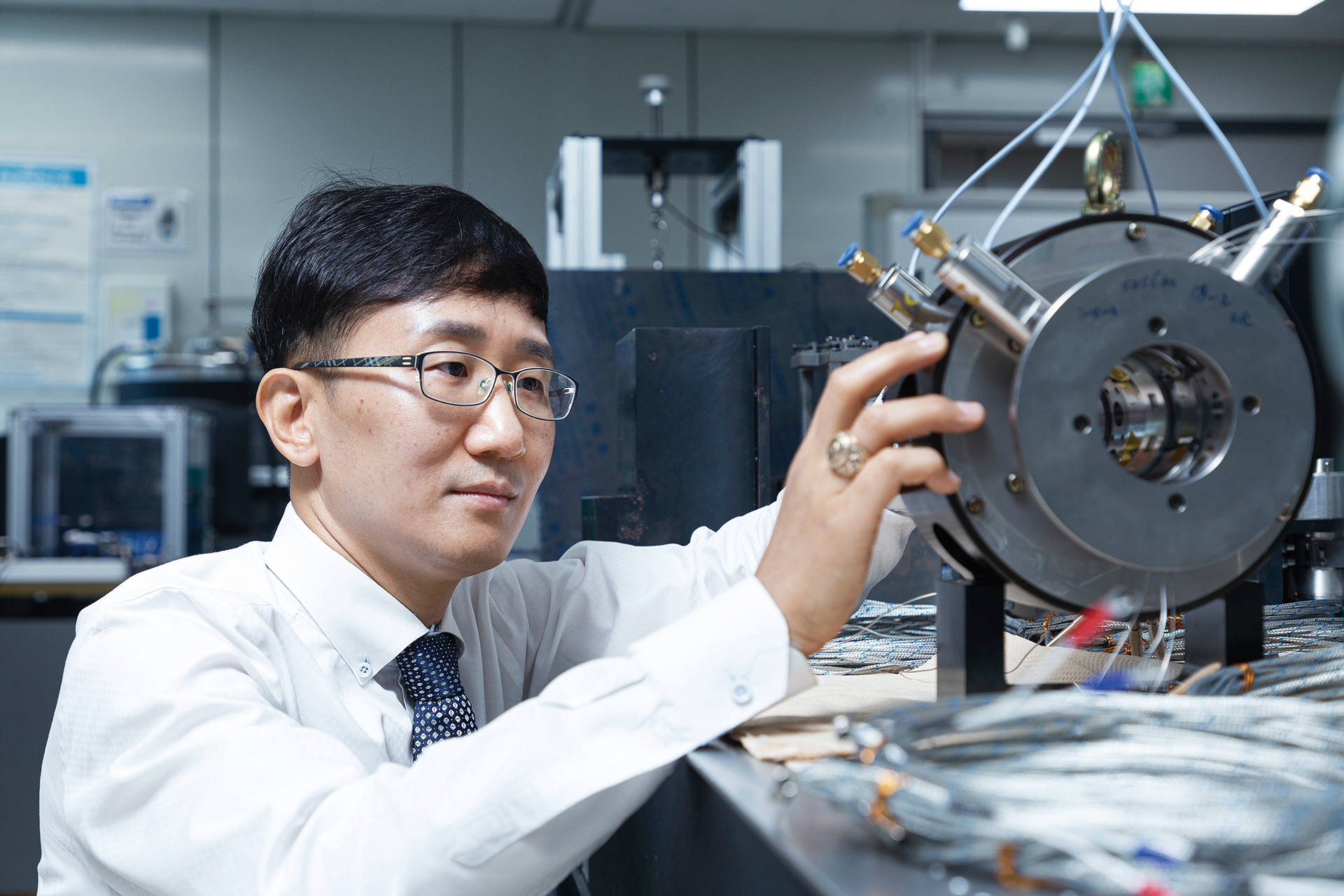Contents VOL. 259

COVER STORY
민간 우주관광이 시작되고, ‘누리호’가 쏘아 올려지는 2021년은 특별한 해로 기억될 것입니다. 인류의 미래 전략시장으로 자리 잡은 우주. <HYPER> 가을호에서는 민간 우주산업 본격화로 촉발된 ‘뉴 스페이스 시대’와 우리의 우주 전략에 대해 알아봅니다.

민간 우주관광이 시작되고, ‘누리호’가 쏘아 올려지는 2021년은 특별한 해로 기억될 것입니다. 인류의 미래 전략시장으로 자리 잡은 우주. <HYPER> 가을호에서는 민간 우주산업 본격화로 촉발된 ‘뉴 스페이스 시대’와 우리의 우주 전략에 대해 알아봅니다.
Scroll Down
As Virgin Galactic and Blue Origin succeeded in their commercial space tour recently, the era of space tourism has begun. It will be soon to explore the unknown world while traveling through space, just like people imagined when they were little. So, how advanced are space development research and technology? We met Professor Ryu Keun from the ERICA Campus’ Department of Mechanical Engineering, devoting to the key machine components development research for a launch vehicle.

기계공학과 류근 교수
Professor Ryu Keun, Department of Mechanical Engineering
우주발사체(Launch vehicles)는 인공위성이나 사람, 화물 등을 지구 대기권 밖 우주 공간으로 이동하는 데 사용하는 로켓이다. 우리가 흔히 우주선이라고 말할 때 떠올리는 외형이 바로 우주발사체다.
최근 우주발사체 개발과 관련해 전 세계적으로 주목받고 있는 것은 적층제조 기술과 메탄 로켓엔진 기술, 발사체 재사용 기술이다. 흔히 3D 프린팅이라고 불리는 적층제조 기술은 기존에 구현이 불가능했거나 제작이 어려웠던 복잡한 형상의 발사체 부품 제작과 엔진 경량화, 구조 단순화, 성능 향상, 개발 및 제작에 투입되는 시간과 비용 절감을 가능하게 한다. 아울러 우주발사체 시장에서 민간기업의 참여가 확대됨에 따라 발사 전반에 들어가는 비용을 줄이기 위해 로켓엔진 운용의 경제성과 신뢰성에 중점을 둔 재사용 우주발사체(Reusable launch vehicles) 관련 연구가 활발히 이뤄지고 있다.
“특히 재사용성과 연료 수급성이 우수한 메탄 로켓엔진에 관한 연구가 지속적으로 늘어나고 있습니다. 메탄 로켓엔진은 기존 케로신(등유) 로켓엔진과 달리 오염 물질을 생성하지 않고, 연소 생성물에 독성이 없어 친환경적이기 때문에 재사용성이 매우 뛰어납니다.”
류근 교수는 행성 탐사 시 해당 행성에서 자체적으로 수급할 수 있어 효용적인 측면에서도 메탄 로켓엔진이 매우 유리하다고 설명했다. 이런 이유로 우주 선진국의 경우 이미 메탄 로켓엔진을 사용한 발사체를 개발하며 원천기술 확보에 힘 쏟고 있다.
Launch vehicles are rockets used to transport satellites, people, or cargo to outer space beyond the Earth’s atmosphere. It is what comes to mind when you think of spaceships.
What is getting global attention related to launch vehicle development are additive manufacturing technology, methane rocket engine technology, and reusable launch vehicle technology. The additive manufacturing technology, commonly known as 3D printing, helps to lessen the time and cost of producing launch vehicle parts that were formerly difficult or impossible to create, lighten engine weight, simplify structures, improve performance, and conduct research and development. Furthermore, as private companies’ participation in the launch vehicle market is increased, research on reusable launch vehicles focused on the efficiency and reliability of rocket engines is actively conducted in order to reduce the overall cost in the launch process.
“An increased number of research on methane rocket engines, which are excellent in reusability and fuel supply, is being carried out. Methane rocket engines do not produce any pollutants unlike previous kerosene rocket engines and have high reusability as it is environment-friendly with no toxin in combustion products.”
Professor Ryu explained that methane rocket engines also have advantages in terms of efficiency, as they can internally supply themselves on the planet while probing. For these reasons, the countries with advanced space technologies are already putting effort into securing fundamental technologies while developing launch vehicles with methane engines.
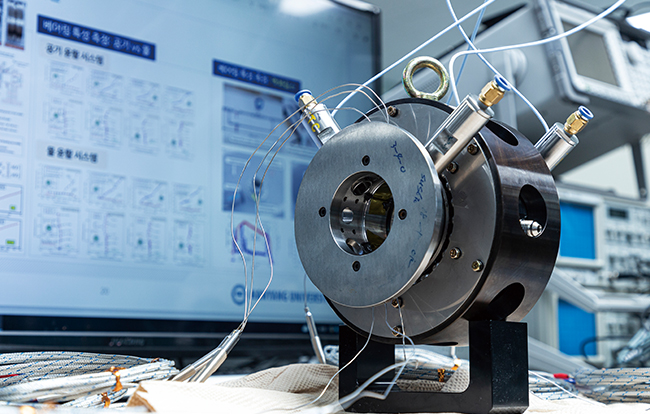
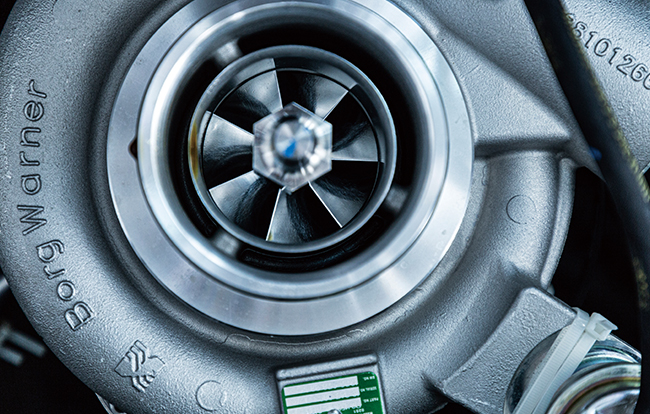
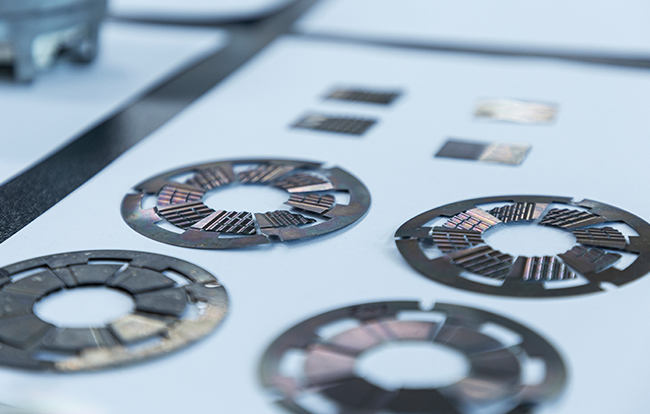
우주발사체 엔진은 매우 복잡하고 다양한 기계 시스템들이 융합된 첨단기술의 결정체다. 로켓엔진은 고체로켓엔진과 액체로켓엔진으로 나뉜다. 일반적으로 고체연료를 사용하는 로켓엔진은 구조가 간단하고 신뢰성이 높지만, 대형화와 유도제어 등이 어렵다는 한계를 가지고 있다. 반면 액체연료 로켓엔진(Liquid rocket engine)은 구조가 복잡하고 개발이 어려운 대신, 대형화가 가능하고 제어가 용이하다는 것이 장점이다. 우리가 흔히 매스컴을 통해 보는 우주발사체는 대부분 액체로켓엔진을 사용한다. 액체로켓은 터보펌프(Turbopump)를 통해 추진제인 연료와 산화제를 높은 압력으로 연소시켜 추진력을 얻는다. 그런 만큼 터보펌프는 우주발사체 개발에 있어서 반드시 필요한 핵심장치라고 할 수 있다.
류근 교수가 연구하는 분야가 바로 우주발사체 액체로켓엔진이다. 류근 교수 연구팀은 지난 2017년부터 과학기술정보통신부 주관의 ‘신진연구지원사업’과 ‘우주핵심기술개발사업’ 그리고 ‘중견연구자지원사업’에 연달아 선정되는 쾌거를 이뤘다. 얼마 전에는 제55회 한국추진공학회 학술대회에서 ‘재사용 우주발사체 액체로켓엔진용 터보펌프에 적용하기 위한 하이브리드 유체 스러스트 베어링의 정하중 특성: 실험과 해석의 비교’를 주제로 최우수발표논문상을 받았다. 이 연구는 향후 액체로켓엔진용 터보펌프 관련 국내 원천기술 확보에 크게 기여할 것으로 기대를 모으고 있다.
“액체로켓엔진을 재사용하기 위해서는 베어링 시스템의 신뢰성과 회전체동역학적 안정성 확보가 반드시 필요합니다. 기존의 액체로켓 엔진용 터보펌프에 사용된 볼베어링은 내구성과 신뢰성에 한계가 있어서 운용 후 재사용이 어렵습니다. 반면 유체 베어링(Fluid film bearings)은 지속적인 사용이 가능하죠.”
유체 베어링의 설계 및 시험평가 기술 개발을 위해 류근 교수는 극저온 유체를 사용하는 터보펌프에 적용할 수 있는 유체 베어링과 회전체 시스템의 설계 기술을 개발하고, 이를 기반으로 제작한 실험장치를 활용해 그 성능을 평가하는 연구를 진행하고 있다. 이와 함께 올해부터는 메탄을 연료로 사용하는 우주발사체용 터보펌프에 적용할 수 있는 베어링과 회전체 시스템 연구도 진행 중이다. 메탄으로 윤활되는 유체 베어링 연구는 전 세계적으로도 그 사례를 찾기 힘든 만큼 독자적인 원천기술 확보에 대한 기대가 무척 크다.
Launch vehicles are a combination of complex and diverse mechanic systems. There are two types of rocket engines—solid and liquid. Usually, rocket engines using solid fuels have simple structures and high reliability, but scaling-up and guided control are difficult. On the other hand, liquid rocket engines have complex structures and are hard to develop but are easy when scaling up and controlling. Launch vehicles that we often see in the media use liquid rocket engines. Liquid rockets create propulsion by combusting fuel and oxidizer, which are propellants, at high pressure through turbopumps. Therefore, turbopumps are necessary parts required for building launch vehicles.
Professor Ryu researches these liquid rocket engines. His research team has accomplished outstanding achievements by being consecutively selected since 2017 for the Ministry of Science and ICT’s “New Research Support Program,” “Core Space Technology Development Program,” and “Mid-career Researcher Support Program.” Recently, they received the Best Presentation Paper Award in the 55th Korean Society of Propulsion Engineers Conference. The title was “Static Load Characteristics of Hybrid Fluid Film Thrust Bearings for Liquid Rocket Engine Turbopumps in Reusable Launch Vehicles: Comparisons between Experiments and Predictions.” This research is expected to largely contribute to securing fundamental technology on liquid rocket engine turbopumps.
“It is necessary to secure the reliability of the bearing system and the safety of rotor dynamics to reuse liquid rocket engines. Ball bearings used in liquid rocket engine turbopumps had limits in durability and reliability, thus making them difficult to reuse. On the other hand, fluid film bearings can be used sustainably.”
For designing and testing the fluid film bearings, Professor Ryu developed the designing technology of fluid film bearings and the rotating system applicable to turbopumps using cryogenic fluids. He researches to evaluate the performance with an experimental device made by the developed technology. This year, he explores the bearing and rotating body systems for launch vehicle turbopumps that use methane as fuels. As research on fluid film bearings lubricated with methane is rarely done globally, securing fundamental technologies is drawing great attention.
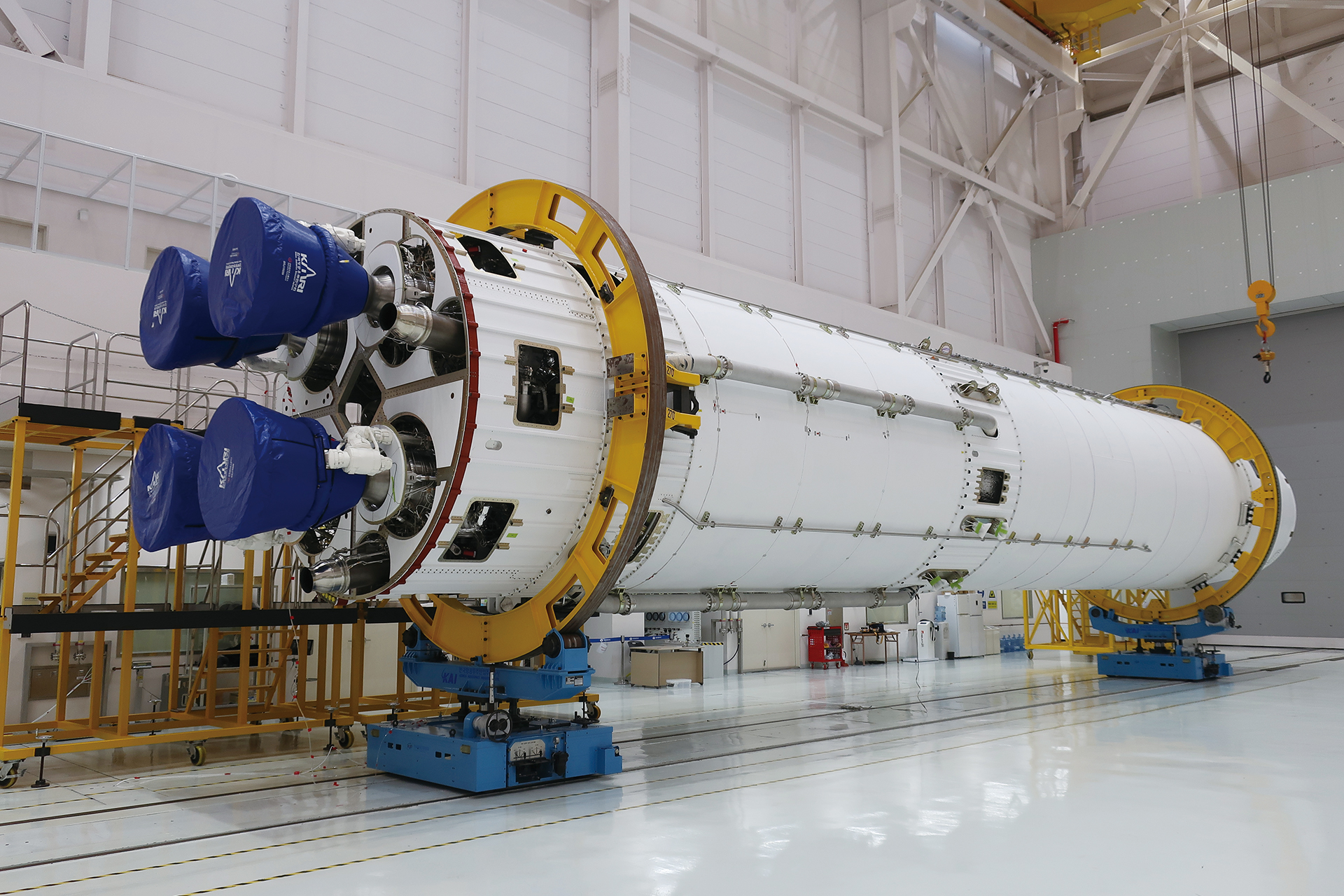
우리나라와 미국의 일반 대중이 우주관광에 대해 느끼는 차이는 확연하다. 일례로 구직 사이트에서 로켓 개발 엔지니어를 검색하면 국내에서는 단 한 개의 회사도 찾을 수 없지만, 미국에서는 손에 꼽을 수 없을 만큼 많은 기업이 화면을 채운다. 우주산업에 뛰어든 민간기업이 그만큼 많다는 뜻이다.
현재 미국, 일본, 러시아, 중국 등 우주개발 선진국들은 축적된 요소부품들의 원천기술을 토대로 경제성과 신뢰성에 초점을 맞춰 개발을 진행하고 있다. 이들은 차세대 우주발사체 개발을 통해 뒤늦게 우주개발에 뛰어든 나라들과 점점 더 기술 격차를 벌리고 있다. 더불어 민간기업과의 기술 협력을 통한 상업화도 빠르게 진행하고 있다.
최근 우리나라는 독자적으로 개발한 75톤급 액체로켓엔진과 7톤급 액체로켓엔진을 탑재한 한국형 우주발사체 ‘누리호’를 개발해 우리의 위성을 우주로 발사할 수 있는 기술력을 확보했다. 이와 함께 한국항공우주연구원을 중심으로 다양한 액체로켓엔진 개발을 병행하고 있다. 이를 바탕으로 2040년까지 다양한 우주 임무 수행이 가능한 대형발사체 플랫폼 기술을 확보할 계획이다. 우주발사체의 엔진 기술은 군사 기술 및 국가 안보와 직접적이고 밀접한 관계가 있는 전략 기술인 만큼 다른 나라에 의존하지 않는 원천기술력 확보가 무척 중요하다. 하지만 안타깝게도 현재 우리나라는 원천기술에 대한 기술력, 특히 기초 단위의 기계요소부품에 대한 연구 인프라와 기술력이 매우 부족한 실정이다.
“국내 우주개발 중장기 계획을 성공적으로 완성하기 위해서는 자체적이고 독립적인 우주발사체 개발과 원천기술 확보가 절실합니다. 국내 우주산업의 기술 자립성 확보는 물론 향후 관련 기술의 수출과 기술이전 측면에서도 중요하죠. 아울러 장기적으로는 현재 정부 주도의 연구 개발에서 상용화를 위한 민간기업 주도 혹은 협력 구조로의 변화가 필요합니다.”
기술력 확보의 핵심은 인재 양성이다. 우수한 젊은 인재들이 우주 기술에 관심을 가지고 꾸준히 몸담을 수 있도록 국가적·사회적 관심과 지원이 절실하다. 정부 지원의 연구소 인력을 확충하고, 민간기업이 도전적으로 뛰어들 수 있는 환경도 조성해야 한다. 우주발사체는 위성 발사와 우주탐사를 위해 꼭 필요한 운송 수단이다. 하지만 국가 간 기술이전이 거의 이루어지지 않기 때문에 독자 개발이 필수라는 것을 반드시 명심해야 한다.
There is a distinct difference in how citizens of Korea and the United States think about space tours. For instance, there is not a single company in Korea hiring rocket development engineers in job search websites, but there are numerous in the U.S., as many private companies are jumping into the space industry.
At present, leading countries in space development, such as the United States, Japan, Russia, and China, are conducting development based on their own fundamental technologies for parts and focusing on economic feasibility and reliability. They are widening the technology gap from the countries that recently joined the space development field through next-generation launch vehicle development. They are also rapidly commercializing the technologies in cooperation with private enterprises.
Lately, Korea independently developed a 75-ton liquid rocket engine and a launch vehicle, Nuri, with a seven-ton liquid rocket engine, securing the technology to launch satellites to outer space. Diverse liquid rocket engines are being developed, led by the Korea Aerospace Research Institute. Korea plans to acquire a largescale launch vehicle platform technology that can carry out various space missions by 2040. As the engine technology for launch vehicles is a strategic technology closely related to military technology and national security, it is essential to secure fundamental technologies. Unfortunately, Korea currently lacks research infrastructures and technologies, especially in mechanical element parts.
“To complete the mid-and long-term plans for space development in Korea, it is imperative to develop launch vehicles domestically and secure fundamental technologies for technological independence in the space industry and future exports of related technologies and technology transfer. In addition, in the long term, there is a need for change from the current government-led research and development to a private company-led or -cooperating structure for commercialization.”
The key to securing technology is training talents. National and social attention and support are necessary to allow excellent young talents to continue working while maintaining interest in space technology. It is also required to expand the workforce in government-supported research institutes and create an environment where private companies can participate eagerly. Space launch vehicles are the essential transport method for satellite launch and space exploration. However, we should remember that independent development is crucial as there is little technology transfer between countries.
